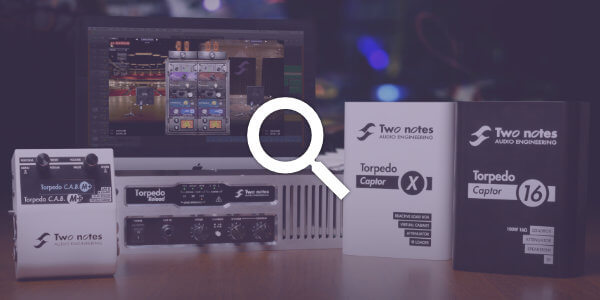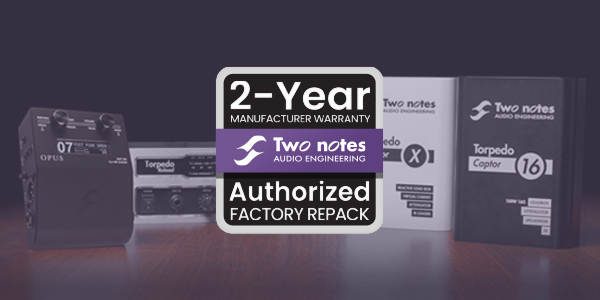The Torpedo Captor X compared to the Torpedo Captor running with a Torpedo C.A.B. M share a few functions, but they also have many differences. If you are uncertain about which one to get, this article will show their similarities and differences, which we hope will help you decide which way to go.
-
Both Torpedo Cap X and Torpedo Captor feature a reactive load box that allows for silent playing/recording of your amp (ie, playing your amp without a speaker cabinet connected). The load box of the Torpedo Cap X is fixed and only comes in two versions, 8 or 16ohms. Torpedo Captor comes in 3 versions: 4,8 and 16 ohms.
-
Torpedo Cap X and Torpedo Captor both feature speaker simulation, which means you can use them for monitoring without using a DAW and Wall of Sound when playing without a speaker cabinet. Torpedo Cap X features the whole Torpedo convolution technology: this DynIR-based technology can accurately reproduce the behavior of a speaker cabinet, 2 microphones and recording room, as well as microphone placement. It comes loaded with 32 virtual DynIR cabinets to tune your tone to your taste. You can use two microphones per cabinet, eq the overall combination and set it in different reverb spaces. The Torpedo Captor’s speaker simulation only has two settings (Guitar and Bass), is not IR-based, and can not be edited, modified, or changed in any way. When you combine a Torpedo Captor with a Torpedo C.A.B. M you have access to the same Torpedo convolution technology for your tube amp sound.
-
Both Torpedo Cap X and Torpedo Captor provide passive power attenuation: you can keep a speaker cabinet connected to your amp and play your amp loud while reducing the volume out of your cabinet.
• Torpedo Captor X features three Volume Levels for the physical cabinet: Low position(-38 dB of attenuation), Halfway position (-20 dB) and Full level (attenuated is bypassed, the full power of the amp is fed into the cabinet).
• The Torpedo Captor features a simple, non-adjustable attenuated output (ATT). It also features a full-range, non-attenuated output (THRU).For more information about the power attenuation of the Torpedo Cap X and Torpedo Captor, and how it compares to our other power attenuator product, the Torpedo Reload, see this article.
-
Torpedo Captor X has 2 XLR outputs. Torpedo Captor X offers 3 different routing options: Stereo, dual Mono (allowing for one output to have a different eq and a different level of reverb) and Dry/wet (one output has the full Torpedo cab sim signal, the other is the dry amp signal of the tube amp). Torpedo Captor + Torpedo C.A.B. M have an XLR DI output and a Line TRS output (through the C.A.B. M). The combination of the two units only sends a mono signal to the PA/audio interface.
-
Torpedo Cap X has a fixed -15 dB input pad to set the level of the signal coming from the amp into the SPEAKER INPUT.
-
Torpedo C.A.B. M has a screen, giving access to all the parameters of the unit without the need to connect to Torpedo Remote with a computer. To have access to all the parameters of the Torpedo Captor X, you need to use Torpedo Remote with your mobile device or your computer.
-
Both Torpedo Cap X and Torpedo C.A.B. M can be controlled by Torpedo Remote with a computer and by a mobile device (iOS and Android).
-
Torpedo Captor X has MIDI capabilities. Torpedo Captor X has a MIDI mini-jack input and is supplied with a mini-jack to MIDI cable.
-
Torpedo Captor X has more effects than the Torpedo C.A.B. M: the Twin Tracker creating a virtual guitarist playing along you from the inputting signal, the Enhancer combining a compressor and a dual eq to polish your overall sound and a Stereo Reverb.
-
Torpedo Captor X has the compact size of the Torpedo Captor, and includes the Torpedo Technology. The association of Torpedo Captor and Torpedo C.A.B. M requires an additional cable and takes more real estate.
-
They all come with a Wall of Sound license (32 virtual cabinets for the Torpedo Captor X, 16 virtual cabinets for the Torpedo Captor and 32 virtual cabinets for the Torpedo C.A.B. M). As stated just above, you don’t need the Wall of Sound to get the Torpedo processing with the Torpedo Captor X and the Torpedo C.A.B. M, but you still get this option, which can come in handy in some situations (typically in the studio or home studio).
You can compare the features of the individual Torpedo products easily, here.





This would be communicated better with a grid of checkboxes + a few asterisks/bullet points. 11 items packed with dense statements about 3 products makes sense to someone who already knows all the features of each unit but is bad marketing and not as concise a comparison as a grid of features in binary Y/N.
Exactly what you requested is in the Torpedo range page…
https://www.two-notes.com/en/torpedo-series/
site de blog grand et incroyable. Je compte vraiment à vous remercier de nous avoir donné beaucoup mieux
d’info.
I was wondering…for home recording purposes would Captor + Wall of Sound perform exactly the same as Captor X?
With WoS you have LOTS more optrions, multiple cans, multiple mics, multiple rooms, multiple reverbs, multiple EQs… just lots and lots more.
Captor X is king for live, for Studio work, WoS is impossible to beat!
TWO questions please…
Is Torpedo CaptorX the same as the older Torpedo Live but in a smaller box?
Is Torpedo Studio the same as Torpedo Live but with two separate outputs as opposed to one mono (Torpedo live)??
THANKS
Eh up Paul, it’s slightly different – inbox me on FB and we can discuss it fully if you want 🙂
Bonjour
je souhaiterai acquérir un two notes torpedo X sauf Que voici mes demandes ?ampli peavey Delta blues en hp 16Ohms (pour two notes captor X )
bonjour ; ma 1ère Question je suis sur le point de racheter le Two Notes torpedo captor X ; est ce que l’on peut le brancher sur mon peavey delta blues sachant que L’ HP et en 16 OHMS ou avoir obligatoirement ??? le modèle two notes captor X en 16 Ohms merci pour votre réponse .
ma 2ème question voila sur cet ampli vintage de 1997 il n’y a pas de sortie jack HP les fils jaune & bleu arrive directement sur L’ HP JE VOUDRAIS SI POSSIBLE avoir votre avis ; voir un plan de montage pour me brancher sur le two notes captor Torpédo X ( blanc ) je vous remercie d’avance pour me solutionner ce problème cordialement a vous et vos Équipes
Please hire a Technical Writer. These should not be numbered steps. It needs a heavy restructure to make sense to the average non-Torpedo user. There is so much assumed knowledge in here. It did not help me make up my mind. I’m still confused about X vs CABM
What would you like to know, Timothy?
Is it possible to use the Captor X without an amp ie to use the cab sim part for use with a multi FX? Ps I have an Amp as well and am interested if I could use for both options. Thanks you
Hi Joe, thanks for reaching out. No, Captor X cannot be used without an Amp; however if you are looking for a compact solution for cabinet modelling, we would suggest our C.A.B. M+.
Please let me know if there is anything else I can help you with.
Kind regards,
Ross
I really want to buy the captor x for my 4 ohm 66 pro reverb, but don’t want to mismatch the impedance. One solution I thought of was buy the CABM and the 4 ohm Captor. instead. Am I getting pretty much the same thing by buying the two products to solve the issue of the captor X not being available in 4 ohm? I’m a little confused.
Hi Terry, there is minimal difference between both setups – the main thing you would loose is the Twin Tracker on Captor X.
Please let us know if there is anything else we can help you with!
Thanks but it’s still unclear…
Can I go: Preamp module -> Torpedo CAB M -> Audio Interface, to record at home?
Or do I need a loadbox somewhere in between?
Hi Frankie, Thank you for getting in touch. Providing you have no poweramp in your signal chain, there is no need for a loadbox.
Please let me know if there is anything else I can help you with today.
Kind regards,
Ross
Ok so the CAB M provides a power amp sim AND a cab sim.
While the CAPTOR provides only a cab sim?
So if I used a regular head, then I would prefer the CAPTOR to attenuate the signal before it reaches the interface?
Sorry if I am oversimplifying lol.
Just put all this in one product for Pete’s sake. And make sure it has a screen. Trying to troubleshoot midi issue at a gig with one of these and no computer or phone handy sounds like a nightmare I’d do anything to avoid. The overlap and lack of features means I now don’t want any of these products. Best of luck with it all.
Thanks for getting in touch, Captor X actually combines the functions of Captor and C.A.B. M+ into one device and providing you have a Phone to hand, you can easily configure the settings. In terms of MIDI issues, our user guide details all MIDI commands Captor X features and for convenience I have linked this below. If you have any specific questions, I am more than happy to assist.
https://wiki.two-notes.com/doku.php?id=torpedo_captor_x:torpedo_captor_x_user_s_manual#midi